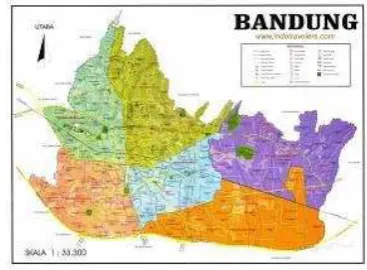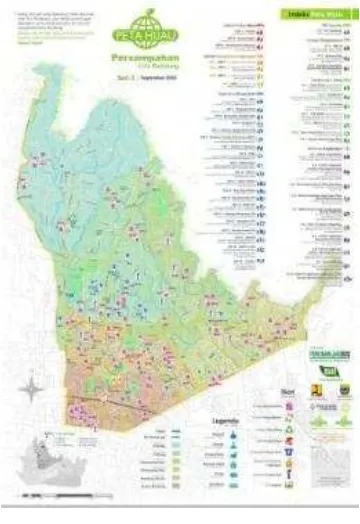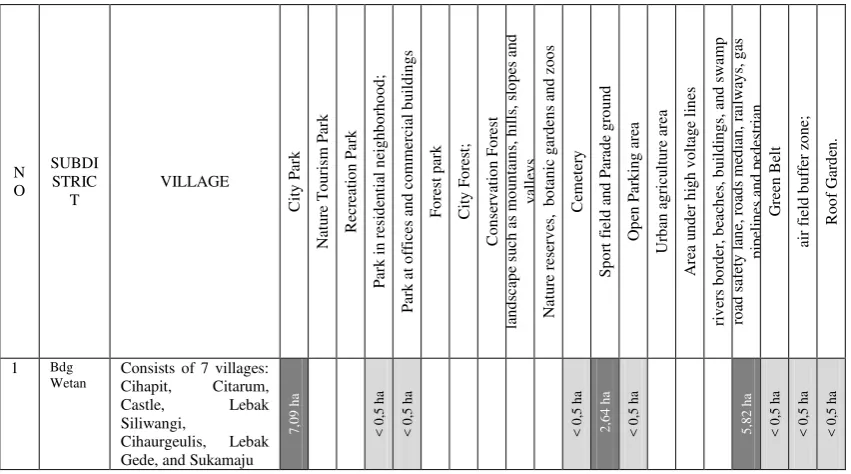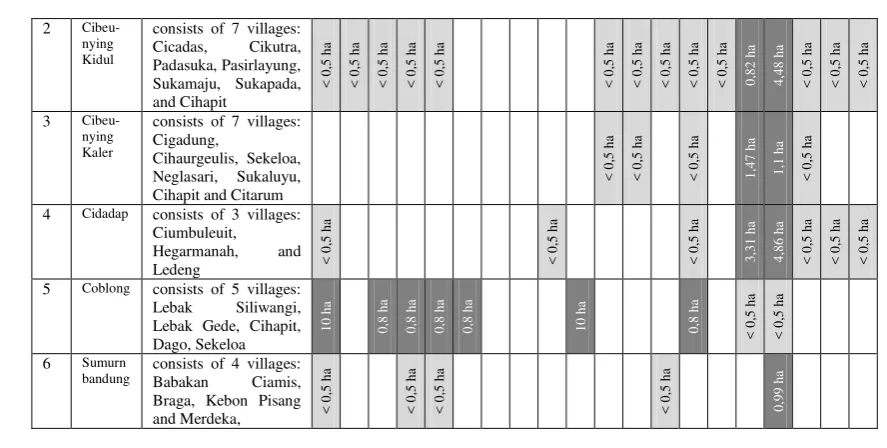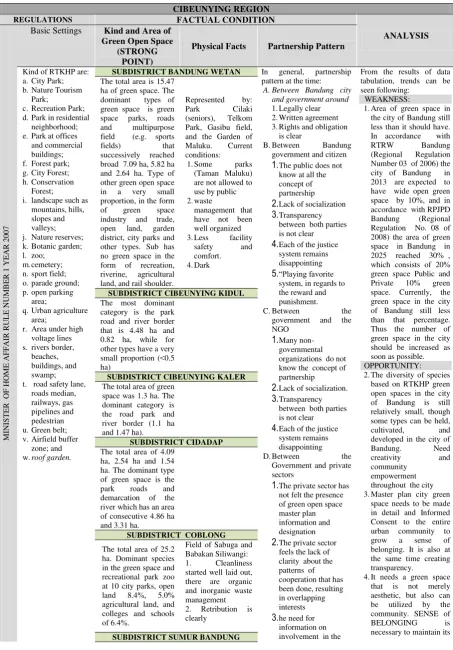IV.11
MOBILIZING THE PARTNERSHIPS MODELS AS A STEP FOR
SUSTAINABILITY IN GREEN OPEN SPACES PROCUREMENT IN
BANDUNG, INDONESIA
Dhini Dewiyanti1, Dewi Kurniasih2
1,2
Department of Architecture Engineering, Universitas Komputer Indonesia 1
[email protected], [email protected]
Abstract
Along with its existence, city bears a function of ecology, social, economy and architectural as well. Green open space, especially in big cities in all over the world today are still inadequate, both in quantity and quality. The condition also occurs in the city of Bandung, the capital of West Java province, Indonesia. Bandung City Government needs to target the addition of this green open space in the coming years. It is not only the responsibility of the Government, but also all citizens and the parties involved.The management through a partnership is one of the alternatives taken by the government in the development and maintenance of green open space to run more optimally. A number of green open spaces in Bandung have a joint venture partnership. The problem that arises is not all those green open spaces increases in quality, some even experiencing decrease.
This paper is a result of study conducted at a number of green open spaces in the city of Bandung, in the region of Cibeunying, conducted during the period from April to October 2010. Through the method of analytical and descriptive approach, this study produces: (a) Factual conditions of the quality of green open space that have undergone partnership management; (b) Formulated evaluation of green open space partnership management in the city of Bandung; (c) Realization of green open space management partnership model between the Government of Bandung City with the various stakeholders of the private sector, state enterprises and society at large in an effort to improve the environmental quality of urban life. It is expected that the results of this study can be useful for the parties involved, so there is sustainability in every process of planning, implementation and maintenance of green open space in the city of Bandung.
Keywords: green open space, management,
partnership, community, model of partnership
1.
Introduction: The Privat
–
Public
(Notoatmodjo, 1992) defines partnership as a formal collaboration between individuals, groups or organizations to achieve a specific task or purpose. It must be based on the sincerity of the parties who have partnered to build strong partnerships based on the sincerity of both parties. However, in order to have a fair profit, it needs to create a balanced partnership relation between the parties. If the strengths of each party are not balanced, the partnership would be merely a sham and fragile. In turn, only one or two parties are benefited, while others will be harmed. The Partnership relies on the bond of mutual efforts and mutual benefit based on the principle of equality and togetherness.
The pattern of partnership is to empower the community spirit which is supported by various strategies now and then. The pattern of equal partnership also requires a strong understanding of the rights, responsibilities and the role of each actor. It is our challenge to develop a spirit and atmosphere that encourages the growth of partnerships and develop patterns that are practical and attractive, ensuring benefits for all parties.
In this case, the parties involved would have to have responsibility, for the partnership is for everyone. Although all parties have responsibilities, the government still must take the initiative, at least to create a stimulating climate for business partnerships, such as by developing policy and a clear development strategy reflected both in purpose, direction and policy indicators. Establish a realistic development priorities followed by all parties, government, private sectors and communities as well. For that an agreement among the various actors is needed, and therefore there should be dialogue.
Building a partnership should be based on the following: (a) common interest; (b) mutual trust and respect; (c) Clear and measurable objectives; (d) Willingness to sacrifice time, energy, and other resources. The principles of partnership are: 1) equality, 2) openness or Transparency and 3) mutual benefit.
II - 12 pattern that includes green open space plan requires preparation on the part of government, private sectors and community as part of the city development. Also, prepare a framework of rules and guidelines which may be a reference to ensure partnerships. Development of partnerships in urban development can include two basic patterns, namely:
1) Participation of private sector and community in development that gives more opportunities to participate in activities which was originally a government task. In other words, the government gave permission to use government-owned assets to private parties and the public to be used within a certain period of time in order to perform public service tasks.
2) Partnership between public, private and government through the development of the for working capital distribution formula, which is the responsibility of each party. Patterns of partnership that includes sharing of the benefits and risks as well is developed in it
2. Evaluation
Evaluation describes the systematic analysis and empirical research of activities and programs, their concepts, conditions, processes, and effects (Rossi, 1999). The aim of evaluation is to describes, to value and to modify programs, procedures, products, institutions, or behavior of person (Bortz, 1995;Wottawa, 1998). Apart from adequate measurement and description, evaluation also values and optimizes processes and products.
Synonimous terms for evaluation are: controlling, impact evaluation, (total) quality management, and responsive evaluation. Some specific terms serve several steps in the process of evaluation (measuring effects), different aims: accountability, certification, empowerment, utility. (Fettermen, 1996).
(Stufflebeam, 1979) suggested that evaluation is the process of delineating, obtaining and providing useful information for judging decision alternatives. Therefore, there are some elements contained in the evaluation: the existence of a process, obtaining, delineating, providing, useful information and decision alternatives. Evaluation is the process of determining significance or worth, usually by careful appraisal and study. Evaluation is the analysis and comparison of actual progress vs. prior plans, oriented toward improving plans for future implementation. It is part of a continuing management process consisting of planning, implementation, and evaluation; ideally with each following the other in a continuous cycle until successful completion of the activity. Evaluation is the process of determining the worth or value of something. This involves assigning values to the thing or person being evaluated.
(http://www.sil.org/lingualinks/literacy/referencemat erials /GlossaryOf LiteracyTerms/ WhatIsEvaluation.htm.)
Evaluation is a process to determine whether the objectives were achieved or not. In general terms the evaluation can be equated with appraisal, ratings and assessment, the words which states attempt to analyze the results of policies in terms of unit value. In a more specific sense, evaluation can be defined as a process of generating information about value or benefit of the policy. Evaluation can also be interpreted as a process of policy analytic procedure used to generate information about policy performance in satisfying the needs, values or opportunities stands as the "problem" (Dunn, 1998).
Therefore, evaluation activities are not only answering the question what happened, why and how, but also to answer what should be done. Broadly speaking, the evaluation can be divided into two, namely:
1) Ex-post Evaluation, an evaluation focus on analysis of the impact of policies or programs that have been implemented. This evaluation reviewed the activities and situations following certain rules or decisions.
2) Ex-ante Evaluation, an evaluation that will foretell or predict the future events and the impact of a policy or program that has not been implemented.
3. Condition of Green Open Spaces in
Bandung
Management of existing green open spaces in the city of Bandung, Indonesia conducted by the two parties: Bandung City Government and private parties. Bandung green open space which is divided in six areas spread in 26 districts is an area of 738.39 hectares or about 4.35% of total area of the city of Bandung. Green open space management is done by the Government of Bandung City. Those areas consist of various categories spread in Bandung regions: Cibeunying; Bojonegara: Karees; Ujung Berung; Tegal Lega; and Gede Bage.
II - 13
Figure 2. Map of Cibeunying Area
Bandung city called City of Flowers, Paris van Java, formerly known as a beautiful city with many parks or green open space. Currently, the city of Bandung has a heavy burden to restore the pride. The last few years the government continued to promote the optimization of green open space in the form of city parks. The development of green open spaces in Bandung covering an area of 1314.20 ha (7.85%) in 2006 to 1466.13 ha (8.76%) in 2007, from 8.76% the 4.35% it is under the management of Bandung City Government, the rest is privately owned. The development of wide green space in the city of Bandung appears in the following table:
Table 1. The development of green open spaces in
the year 2006-2007
Source: Landscaping Services, Bandung.
In accordance with the Spatial Plan of Bandung (Regional Regulation Number 03 of 2006) the city of Bandung in 2013 are expected to have the amount of green open space by 10%, and in accordance with RPJPD Bandung (Regional Regulation No. 08 of 2008) the area of green open space in Bandung in 2025 reached 30%, consisting of 20% Public green open space and 10% Private green open space. In
addition to green open spaces, Bandung also has 13 Public Cemetery i.e. Moslem cemetery, Christian cemetery, Hindu and Buddhist cemetery in 6 parts of the city with a total area of 124,000 m2. Given the total population of a large city, the future of green open space in the form of cemetery is quite promising.
Area of green open space managed by private parties such as private/individuals or institutions outside the Government of Bandung City in accordance with the categories according to regulatory interior minister is an area of 3447.73 ha. From that area of private green open space, the 139.68 ha of which are potential private area that can be developed by the City of Bandung since it comes from the school garden category, military area, garden/land in EHV transmission lines and recreational parks. The other green open space that also has great potential to be maintained is an area of 1446.01 ha of Environment Park, with the management is conducted by the community or the government in the level of village
Figure 3. Green Open Space which already have
partnership with educational institution
Green open spaces, large and small are scattered in 26 districts. The difference is due to urban development plans in each district, adjusted for the location characteristics of each district. The largest green open space is in the district of Cicadas with an area of 145.12 ha. Kiaracondong is the lowest (0.18 ha), while the other 24 districts ranges from 1.5 ha to 16 ha.
Figure 4. Green Open Space which already have
partnership with banking institution
Kind 2006 2007
extensive % extensive %
Park 120.95 0.72 129.45 0.77
Nursery 1.69 0.01 1.69 0.01
Grave 141.06 0.84 145.50 0.87
Green open space
II - 14 Based on categorization at a green open space (the Minister of Home Affairs, 2007) at the level of regions and districts, not all such categorization can be found. This is due to the characteristics of the region and direction of urban development, so it will be found one type of broad categories of green open space while other types do not exist.
Figure 5. Green Open Space which already have
partnership with surounding communites
Referring to the comparison of Bandung land use type broad and the conversion, certainly agriculture area is still the broadest one. However, considering the conversion of land that is quite high, the agricultural land is the area most prone to decrease compared to other regions. Yet the potential of settlements to develop a large green open space
considering the condition/land use type formations that are more stable and has the potential development to be multifunctional green openspaces. Other areas with the potential to be maintained as green open space is the area of offices, regional campus/school and military areas, although in all three areas a better approach like maintaining green space in accordance with the provisions of urban planning and maintaining green space as a form of contribution in The city of Bandung is need to be done. Here are categories, distribution and extent of green open space of each region.
Referring to the comparison of Bandung land use type broad and the conversion, certainly agriculture area is still the broadest one. However, considering the conversion of land that is quite high, the agricultural land is the area most prone to decrease compared to other regions. Yet the potential of settlements to develop a large green open space considering the condition/land use type formations that are more stable and has the potential development to be multifunctional green openspaces. Other areas with the potential to be maintained as green open space is the area of offices, regional campus/school and military areas, although in all three areas a better approach like maintaining green space in accordance with the provisions of urban planning and maintaining green space as a form of contribution in The city of Bandung is need to be done. Here are categories, distribution and extent of green open space of each region.
a.
Category, Distribution and Area of Green Open Space in the Cibeunying Territory
Category, distribution and Area of Green Open Space in the Cibeunying Territory can describes in the following table:
Table 2. Category, distribution and Area of Green Open Space in the Cibeunying Territory
II - 15
Cihapit and Citarum <
0,
Space Partnership Pattern Concept
Management of urban green open space which involves partnerships with communities, private institutions/body corporate and/or individuals starting from the vision and mission development, planning, utilization, and control. Community partnerships can be done in the decision making process regarding the green open space management, cooperation in the management, contribution of ideas, financing and physical energy for the execution of work.
Mutually beneficial cooperation system in this partnership is expected to empower all citizens of the city of Bandung and the private sector. This partnership is also expected to enhance the role of communities, partnerships with community organizations, businesses, regional cooperation, national, international in the management of green space in the city of Bandung. This is expected to bring into reality: (1) the quantity and quality of private green open space, (2) patterns of community-based park maintenance, (3) gardens built by the private and public, and (4) incentives for community participation in the management of green open space in the City Bandung.
Partnership in management of green open space the city of Bandung.
The purpose of green open space management partnerships in the city of Bandung is to build a partnership that can benefit all parties. The success of partnerships in the management of green open
space in the city of Bandung is highly dependent on several factors:
a. the role of Bandung City Government and active green open space stakeholders with strong synergy;
b. mutual respect among members of partnerships; c. the existence of conformity among the
participants based on mutual respect and trust; d. the realization of the interdependence among the
participants;
e. the creation of green open space management synergy program
f. the transparency of information;
g. the strength of integrity, patience and constancy; h. support of trained resources.
The concept of partnership can be based on complementary model theories that can explain business networks: first, the exchange perspective and the second: model of resource dependence which inspired many studies and business organizations.
II - 16 To avoid partnership management of green open space in the city of Bandung harming each other on both sides, co-operation can be held between the Government of the City of Bandung and universities, practitioners / professionals / developers as well as citizens of the city by taking into account the principle of mutual help, mutual resolve, mutual benefit and mutual respect.
Core values that need to be upheld in realizing the green open space management partnerships in the city of Bandung are honesty and integrity. The partnership between the parties to cooperate is not only considering the elements of business, but more than that is oriented toward constructing as an effort to encourage the management of green open space to be more modern and professional. Through a cooperation network, transfer of resources, experience, knowledge and technical skills usually occurs, as well as other aspects, to create efficiency. Partnership in the management of green open space in the city of Bandung is between the formal sectors, formal sector with non-formal sector and between informal and non-formal sectors. The difference lies in the presence of the legality of the collective agreement between the partners. Formal and informal partnership should be based on a written agreement with a set of legal basis within. The informal-informal partnerships are usually based on mutual trust among the elements of partnership.
c.
Actor Concept and Partnership Pattern
Form
So far the city government has made a partnership with parties: Local neighbor, Government Private as: the Banks, restaurants entrepreneurs, shops, and industry, NGOs, communities, especially the one closest to the green open spaces of the city itself. Forms of partnership between the government of Bandung and private sectors or the community can be developed through the maintenance of city park or green belt in the community.
d.
Partnership strategy concept in the
management of Green Open Space
Open space managers community should stand with the vision of a decentralized land use planning and natural resource conservation.
On the relationship occur from this partnership strategy, trust and commitment is very influential. Nevertheless, a real reason to form a partnership strategy between partners is to improve the performance of the partnership which is shown by an increasing program, the number of partners who join in and partner satisfaction in the form of willingness to cooperate in the long-term program. Resource-based partnerships strategy will be able to achieve
competitive advantage through the accumulation of resources utilization.
4. SWOT Analysis to be used to
evaluation the partnership strategies in
the management of green open space in
the city of Bandung
SWOT analysis is a systematic identification of the various factors that can be used to formulate the partnership strategies in the management of green open space in the city of Bandung. This analysis is based on a logic to maximize the strength and opportunities, while at the same time minimize the weaknesses and threats. Strategic decision-making process is always associated with the development of mission, goals, strategies, and policies of green open space. Thus, strategic planner must analyze strategic factors of green open space program (strengths, weaknesses, opportunities and threats) in existing condition. This is called Situation Analysis. Analysis Table Between Regulations and Factual Condition is shown in Table 3
5. Conclusion
The following findings emerged from the analysis, obtained: Factual conditions that have undergone quality green space management partnerships: (a) Currently Bandung has a green open space area of 8.76% of the whole area of the city, where 4, 35% is the new partnership developed by the city government. Target in 2025 is to have 30% green open space, with 20% of it is cultivated through a partnership; b) Not all of the 4.35% green open space that has been partnered are in good condition, depicted in the Condition Of Green Open Spaces diagram is shown in Table 4
It appears that the private partner is more committed in running a partnership, establishing mutually beneficial working relationship. It is needed to encourage better cooperation in a wider scale
Formulating evaluation of partnership in the management of green space in Bandung: (a) There are still many who do not know the concept of partnership launched by the City Government in establishing green open space maintenance. In this case the municipal government still needs a lot of socialization and promotion effort; (b) The supervision mechanism on the partnership sustainability process has not been well established. Still there are those who feel the inequality in employment, so the impact on stranded green space conditions. The government needs to establish a separate independent body that can oversee this cooperation.
II - 17 can be made between the Government of Bandung City with the various stakeholders of the private sector, state enterprises and society at large in an effort to improve the environmental quality of urban life, especially the city of Bandung, in the form of participation starting from the vision and mission development, planning, utilization, and control of green open space; (b) Partnership in the management of green open space in the city of Bandung city park maintenance can be a green belt in the neighborhood or community. This form can be done with cooperation between the Government of Bandung City with the Government District around, between Bandung City Government and society, between Bandung City Government and NGOs and between the City of Bandung and the private sector; (c) What is needed in developing a partnership strategy is the increase in resources, quality of relationships, flexibility, cooperative relationship continuity expectations and information dissemination; (d) Partnership in the management of green open space in the city of Bandung, also can be carried out in various patterns, namely: (1) Plasma core, which describes the partnership between the Government of Bandung, public and private sector, which includes the government as the core and the public/private sector as the plasma. The city government will guide the provision of facilities ranging from land, technical assistance to the implementation and maintenance of green open space; (2) Sub-contracts, is a cooperation in product relations by the partners to be part of the activities; (3) Franchises, partnerships in which the Franchisor grants the franchisee the right to use the area along with management aid and policy guidance; (4) Agency partnership that includes given right to the community to manage the green open space in the city of Bandung.To include the community in ways of participation will lead the management to be easier and inexpensive, like to involve communities to maximize the function of green open space in the city of Bandung. The focus of the management of green open space in the bureaucratic management should not be complicated. The Government then continues to educate people to be able to participate in managing the green open space.
The government still had to run what has been planned with community involvement in maintaining green open space in the city of Bandung. The existing rules should be followed up with the collaboration with various parties. Cooperation is among government agencies, as well as with artists and design experts from universities to develop a mapping of green open space in the city of Bandung, which produced "Green Map" to increase the area of green open space as well as to develop its management aspects.
The government must have properiety standards which are intended to ensure that an evaluation will
be conducted legally, ethically, and
w
ith regard to the welfare of those involved in the evaluation, as well as thoses affected by its results. The containt of standards are: Service Oroentation, Formal Agrrements, Rights of Human Subjects, Human Interactions, Complete and Fair Assessment, Disclosure of Findings, Conflict of Interest and Fiscal of Interest.6. Recomendation
According to the conclusion, the recommendations are as follow: (a) A green map of Bandung is needed to be built; (b) Rules on partnerships in the management of green space in the city of Bandung should be strengthened; (c) The need for technical guidelines on the management of green open space in the city of Bandung.
7. References
Bortz and DÓring, Wottawa & Thierau (2001) in Rindermann, Heiner, “Evaluation”, Otto – von – Guericke – Universitat Magdeburg, pp 309 – 329.
Dunn, William N., (1988). “Pengantar Analisis
Kebijakan Publik”, edisi kedua,
Yogyakarta:Gajah Mada University Press, pp. 25-80.
Fettermen, Kaftarian & Wandersman. (1996). “ Empowerment Evaluation. Knowledge and Tools for Self-Assessment and Accountability”, Thousands Oaks: Sage, pp. 65 – 80 http://www.sil.org/lingualinks/literacy/referen cematerials /GlossaryOf LiteracyTerms/ WhatIsEvaluation.html
Notoatmodjo, Soekidjo. (1992). “Pengembangan Sumber Daya Manusia”, PT. Rineka Cipta, Jakarta, pp.35-65.
Rossi, P.H; Freeman, F.E & Lipsey, M.E. (2001) “Evaluation – A Systematic Approach “, in Rindermann, Heiner, “Evaluation”, Otto – von – Guericke – Universitat Magdeburg, pp 309 – 329.
Sobirin. (2007). “Catatan Sobirin/ DPKLTS,
30/8-2007”,
http://sobirin-xyz.blogspot.com/2007/08.
Stufflebeam in Worthen and Sanders (1979:129),
“Evaluasi Pendidikan”, http:
//evaluasipendidikan.blogspot.com/2008/03/e valuasi-program-sebuah-pengantar.html. The Minister of Home Affairs Regulation No. 1 year
II - 18
Table 3. Analysis Table Between Regulations and Factual Condition
CIBEUNYING REGION
REGULATIONS FACTUAL CONDITION
ANALYSIS
Physical Facts Partnership Pattern
Kind of RTKHP are: a. City Park; b.Nature Tourism
Park;
c. Recreation Park; d.Park in residential
neighborhood;
i. landscape such as mountains, hills,
SUBDISTRICT BANDUNG WETAN In general, partnership pattern at the time:
A.Between Bandung city and government around 1.Legally clear 2.Written agreement 3.Rights and obligation
is clear
B.Between Bandung government and citizen
between both parties is not clear 4.Each of the justice
system remains disappointing
5.“Playing favorite
system, in regards to the reward and organizations do not know the concept of partnership 2.Lack of socialization. 3.Transparency
between both parties is not clear 4.Each of the justice
system remains disappointing
D.Between the
Government and private sectors
1.The private sector has not felt the presence of green open space master plan information and designation 2.The private sector
feels the lack of the city of Bandung still less than it should have. In accordance with
RTRW Bandung
(Regional Regulation Number 03 of 2006) the city of Bandung in 2013 are expected to have wide open green space by 10%, and in accordance with RPJPD Bandung (Regional than that percentage. Thus the number of relatively small, though some types can be held, cultivated, and throughout the city 3.Master plan city green
necessary to maintain its The total area is 15.47
ha of green space. The dominant types of green space is green space parks, roads and multipurpose field (e.g. sports
fields) that
successively reached broad 7.09 ha, 5.82 ha and 2.64 ha. Type of other green open space in a very small proportion, in the form of green space are not allowed to use by public other types have a very small proportion (<0.5 ha)
SUBDISTRICT CIBEUNYING KALER The total area of green
space was 1.3 ha. The dominant category is the road park and ha. The dominant type of green space is the park roads and demarcation of the river which has an area of consecutive 4.86 ha and 3.31 ha.
SUBDISTRICT COBLONG
The total area of 25.2 ha. Dominant species in the green space and recreational park zoo at 10 city parks, open land 8.4%, 5.0% agricultural land, and colleges and schools of 6.4%.
II - 19 The dominant type of
green space is a garden path that is equal to 0.99 ha and other green space has an area of less than 0.5 ha.
Traffic Parks: 1. Garbage problem 2. The condition of the goods / equipment is less manicured and out of date
3. Dark
joint, so as to create transparency in the activities and funding 4.Lack of program
socialization. 5.Transparency
between both parties is not clear 6.Each of the justice
system remains disappointing Private still feel an injustice, especially those dealing with sanctions
existence.
5.Complete green space with garbage can, there should be cooperation with the relevant department to provide community learning about sorting garbage disposal.
Table 4. Condition Of Green Open Spaces
No CONDITION
NEIGHBOUR
GOVERN
MENT
PARTNERS
NGO
PARTNERS
PRIVATE PARTNERS
SOCIETY
PARTNER
S
EDUCATION
PARTNER
S
Bank Hotel retail
industry Office
1 Cleanness quality poor poor good good fair fair fair fair fair
2 Facilities and Infrastructure: such as benches, garden lights
fair fair good good good fair good fair fair
3 Park aesthetic fair fair good good good good good fair fair
4 Safety fair fair good fair good fair good good Good
5 Comfort fair fair good good good fair good fair good
